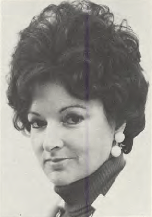Elizabeth Peer facts for kids
Elizabeth Clow Peer Jansson (February 3, 1936 – May 26, 1984), often called Liz Peer, was an important American journalist. She worked for Newsweek magazine from 1958 until her death in 1984. She started her career at Newsweek as a copy girl. This was a time when there were not many chances for women in journalism.
In 1962, Osborn Elliott promoted her to a writer. Just two years later, she went to Paris. There, she became Newsweek's first female foreign correspondent. She returned to the United States in 1969. She worked in Newsweek's Washington, D.C., office. In 1975, Peer went back to Paris as the head of the bureau. She made history again in 1977. She became Newsweek's first female war correspondent. This happened when she reported on the Ogaden War.
Contents
Growing Up and College Years
Elizabeth Peer was born in East Orange, New Jersey. Her birthday was February 3, 1936. Her parents were Dr. Lyndon A. Peer and Ruth Banghart Peer. Both of her parents had gone to college.
Her father, Lyndon, was a plastic surgeon. He started the plastic surgery department at St. Barnabas Hospital. Her mother, Ruth, graduated from Wells College.
Elizabeth went to the Connecticut College for Women. She graduated in 1957. She studied philosophy and loved the arts. She first worked as a reporter for the student newspaper. Later, she became its cartoonist. She also acted in plays during her time at college.
Starting a Journalism Career
After college, Elizabeth Peer moved to New York City. An employment agency helped her get a job at Newsweek. She started as a copy girl in 1958. At that time, Newsweek had very few women writers. An editor even told her to "go somewhere else" if she wanted to write.
But Peer was adventurous. In 1960, she famously hid under a table. She wanted to listen in on a meeting of the Civil Aeronautics Board. This kind of daring behavior got the attention of Newsweek's editors.
The magazine's culture began to change in 1961. Phil Graham bought Newsweek. He promoted Osborn "Oz" Elliott to editor. Elliott gave Peer a chance to try writing. She was the only woman to get such a tryout between 1961 and 1969.
Breaking Barriers as a Correspondent
In 1964, Newsweek sent Peer to Paris. She became the magazine's first female foreign correspondent. Even though she didn't get a raise right away, she proved herself. She was tough and fluent in French. She covered many topics, from politics to fashion.
Lynn Povich, another journalist, remembered Peer. She said Peer could handle herself with the "macho crowd" of foreign reporters. Peer wanted to cover the Vietnam War while in Paris. But she was not allowed because she was a woman.
In 1969, Peer came back to the United States. She worked in Newsweek's Washington, D.C. office. She covered important areas like the State Department and the White House.
Challenges and Achievements
In 1970, many women at Newsweek filed a complaint. They felt they were not treated fairly. This was with the Equal Employment Opportunity Commission. Peer did not join the complaint. But she was very supportive of the women.
Peer moved to New York City in 1973. She kept writing for Newsweek. A story she wrote about Barbara Walters won an award. Newsweek had agreed to promote a woman to senior editor. Peer seemed like the best choice. She even acted as a senior editor for a short time.
However, Peer did not become a senior editor. The reasons are not fully clear. After this, she turned down a job offer at the White House. In 1975, she returned to Paris as the bureau chief.
In 1977, Peer achieved another first. Newsweek sent her to cover the Ogaden War. This was a conflict between Ethiopia and Somalia. She became Newsweek's first female war correspondent. Her reporting won her a major award, the "Ed Cunningham Award."
Later Life and Legacy
While covering the Ogaden War, Peer broke her coccyx (tailbone). This injury caused her constant pain. She returned to New York in 1978. She married John P. Jansson, an architect.
She continued to write for Newsweek. But her pain made it hard to work. In 1980-1981, she and her husband took a year off. They sailed around North America and the Caribbean. Peer wrote about their adventures for a boating magazine.
In October 1981, Peer received an honor from her college. She was given the Connecticut College Medal. This award is for alumni who have achieved great things.
Elizabeth Peer passed away on May 26, 1984. Her funeral was held in New York City. Her former editor, Osborn Elliott, spoke at the service. Newsweek created the "Elizabeth Peer Scholarship Fund" in her memory. This fund helps students at the Columbia University Graduate School of Journalism. Her writings and papers are kept at the American Heritage Center at the University of Wyoming.


